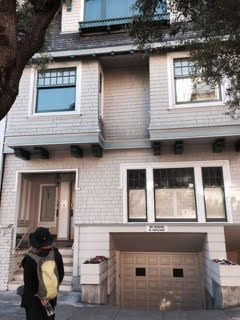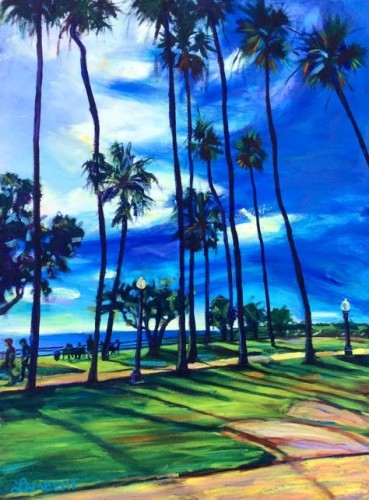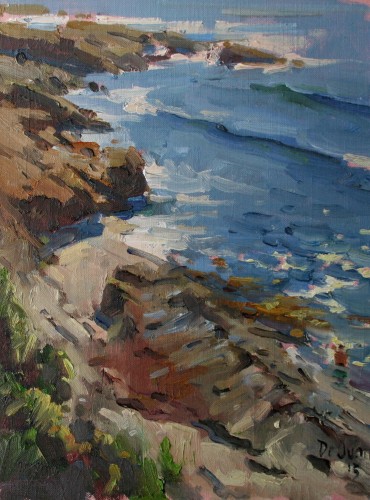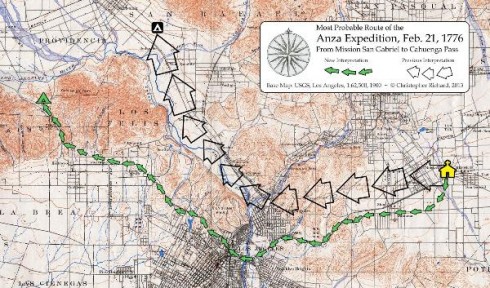Honey goes down the first roads in California
NOTES FROM ABOVE GROUND
By Honey van Blossom
(Honey is a Belgian Marxist former strip-tease artiste)
Saturday I joined a Greenbelt Alliance hike through the Black Diamond Mines Regional Park, which is roughly between Clayton and Antioch. Black Diamond refers to the coal mined there between about 1860 to the early 20th century.
The Greenbelt Alliance has for sixty years worked for the preservation of open spaces and agricultural land. The hikes it sponsors and co-sponsors take people in the Bay Area into wonderful places – as does the Sierra Club and other public interest organizations.
It had rained heavily a few days before we started on the hike. The hills were vibrantly green. One of the leaders remarked that the human cones in the eye are more sensitive to green frequencies than any to any other color. Color isn’t real; that is, all colors are only electromagnetic radiation, which is a spectrum.
We may have more sensitivity to shades of green because human beings evolved in Africa, and it was green. Prey animals need to see what doesn’t belong in a green background. Predators usually – not predator birds of course — approach from the ground. Once a prey animal sees a predator, it then needs to see where to go. Read more
Honey ponders California’s Golden Bough – deep ecology writing
NOTES FROM ABOVE GROUND
By Honey van Blossom
(Honey is a Belgian Marxist former strip-tease artiste)
Supreme Court Justice William O. Douglas dissented to the majority decision in Sierra Club v. Morton (1972) 405 U.S. 727. The suit arose when the United States Forest Service permitted development of Mineral King then near Sequoia National Park — a national park in the southern Sierra Nevada east of Visalia, known for its giant sequoia trees. Mineral King is a subalpine glacial valley located – since 1978 — in the Southern part of Sequoia National Park.
In 1972, Douglas wrote:
“Inanimate objects are sometimes parties in litigation. A ship has a legal personality, a fiction found useful for maritime purposes. The corporation sole – a creature of ecclesiastical law — is an acceptable adversary and large fortunes ride on its cases…. So it should be as respects valleys, alpine meadows, rivers, lakes, estuaries, beaches, ridges, groves of trees, swampland, or even air that feels the destructive pressures of modern technology and modern life. The river, for example, is the living symbol of all the life it sustains or nourishes—fish, aquatic insects, water ouzels, otter, fisher, deer, elk, bear, and all other animals, including man, who are dependent on it or who enjoy it for its sight, its sound, or its life. The river as plaintiff speaks for the ecological unit of life that is part of it.”
In this dissent, Justice Douglas indicated a shift away from environmentalism through regulatory laws that manage environmental degradation towards the legal position that “trees have standing,” or, rather, “Rights of Nature.” Read more
Honey travels through California’s geographic, plant, animal and bird past
NOTES FROM ABOVE GROUND
By Honey van Blossom
(Honey is a Belgian Marxist former strip-tease artiste)
Credit for the image is Bonnie Lambert’s “Palisade,” tall palms against the sky in Santa Monica. bonnielambert.com.
Copyright 2015. Permission to use granted by the artist.
Kern County in the southern end of the Central Valley of California began keeping tally of drowning deaths in the Kern River in 1968. As of May 2015, the sign at the entrance to Kern Canyon states that total is 271.
Before Kern County began its tally, children swam in the Kern River. Those of us who survived remember the powerful rush of water pushing us through champagne-colored water, flecks of gold swimming around us glittering like gold minnows in the place just before the rapids.
The Kern River is one of the main waterways that drain the southern part of the Sierra Nevada Mountains in California. In 1853, Richard M. Keyes discovered gold in a quartz vein a few miles from the present community of Lake Isabella in the Kern River Valley. An instant mining town called Keyesville sprang up at the site. In 1858, an Indian called Lovely Rogers chased his mule. He picked up a rock to throw at it, and the glint of gold in the rock caught his eye. Rogersville began at the entrance to the gold mine, shaded by California bay laurels. Read more
Honey on El Camino Viejo
NOTES FROM ABOVE GROUND
By Honey van Blossom
(Honey is a Belgian Marxist former strip-tease artiste)
This is the map of downtown, courtesy of The Los Angeles Public Library with the Ord survey of 1849 as an insert. You can also see City Hall built on the streets that were configured in 1928. Click on map to see a larger version.
A billboard on Sunset Boulevard in Los Angeles welcomes travelers to Dodgertown. Dodgertown is not a town although it has its own zip code, thanks to the Los Angeles City Council. It is a stadium and nearby Dodger-owned property. If the Mayor leaves City Hall at 200 North Spring and drives along Sunset Boulevard to Stadium Way and then up through Dodgertown, he will travel along the trunk of what was called El Camino Viejo in the now City of Los Angeles.
When the first Europeans arrived in Southern California, they encountered a plain of tough chaparral – the plants impenetrable in their hardness and thickness — ground squirrel holes, rivers that were then much more like rivers than they are now, big rocks, steep hills, creeks and marshes. The explorers traveled through this rough terrain on a native trail, guided by natives, and greeted by friendly natives that presented them with trays of seeds. The trails the explorers traveled along were eventually called El Camino Viejo. El Camino Viejo was composed of several trails that all came into aboriginal Los Angeles and left from it. Read more
Hudson Bell of Fern Hill takes Honey on an historic walk through San Francisco
NOTES FROM ABOVE GROUND
By Honey van Blossom
(Honey is a Belgian Marxist former strip-tease artiste)
 Ina’s_house is by Feride B. Diri, showing Honey looking at Ina Coolbrith’s house on Broadway
Ina’s_house is by Feride B. Diri, showing Honey looking at Ina Coolbrith’s house on Broadway
Juan Bautista de Anza sited the fort called El Presidio Real de San Francisco on March 28, 1776. A year later, Jose Joaquin Moraga built the garrison, numbering 33 men. By 1825, the Presidio had 120 houses and perhaps 500 people, mostly women and children. The Mexican government recognized the Presidio as a pueblo in 1834. According to W. W. Robinson, relying on attorney John Whipple Dwinelle’s argument in the United States District Court case titled The City of San Francisco v. The United States (published as a book in 1863) by 1835 “ the population was shifting from the table land above the sea to the sheltered cove adjacent to Telegraph Hill where the table land above the sea to the sheltered cove adjacent to Telegraph Hill where the village of Yerba Buena was being born…. Until 1846 alcaldes and justices of the peace in Yerba Buena granted town lots to its inhabitants, the first conveyance being to William A. Richardson on June 2, 1836, of a 100-vara lot in the northwest corner of Grant Avenue and Washington Street.” For a year Richardson — a naturalized Mexican citizen — lived in a canvas tent, and then he built a house.
In 1846 a couple of hundred people inhabited the village of Yerba Buena. “Yerba Buena” is the Spanish name for a number of aromatic plants, most of which belong to the mint family. The plant grew in abundance adjacent to the Mission San Francisco de Asis, founded by Moraga and Father Francisco Palou in 1776. Read more
Honey thinks about the Astrolabe and the Compass and of Apple Inc.
NOTES FROM ABOVE GROUND
By Honey van Blossom
(Honey is a Belgian Marxist former strip-tease artiste)
Picture of Pacific Ocean by Jose L. de Juan, copyright 2015.
Jules Vern’s Captain Nemo (Meaning “no one” from Homer’s Odysseus – Odysseus said he was “No Man.”) traveled 20,000 leagues under the sea in a submarine. The title did not mean the Nautilus went 20,000 leagues deep in the water but that the vessel traveled 20,000 leagues while under water. The nautilus (from the Latin form the original Greek word “sailor”) is a marine mollusk, and its bony body structure is externalized as shell divided into chambers. The planisphere mentioned below was a star chart the shows the celestial sphere on a plane.
The narrator of the novel writes: Read more
Honey goes around and around Griffith Park with Anza
NOTES FROM ABOVE GROUND
By Honey van Blossom
(Honey is a Belgian Marxist former strip-tease artiste)
This is an undated photograph of members of the Cahuenga village camping on the
Cahuenga Pass. Anza Society website.
Old Way Stack Cropped is the map that accompanies Professor Quinn’s essay on the
Anza route. I got it from the Anza Society website.
It’s well known that Walt Disney first thought up Disneyland when he was sitting on a bench in front of the merry-go-round in Griffith Park (4730 Crystal Springs Drive). The Department of Parks and Recreation donated the bench to Main Street, U.S.A., so you have to go to Anaheim to see it. It’s currently on display in the Opera House lobby. James Dean’s bronze bust at the Griffith Park Observatory atop Mt. Hollywood (on the sidewalk to the west of the main lawn) commemorates the making of key scenes in Rebel Without A Cause. The 1960s Mission Impossible television series used the merry-go-round, the observatory, the tunnel – I think that’s the same tunnel as in Who Framed Roger Rabbit that is the entrance to Toontown – and the Bronson Caves. Griffith Park also sometimes played other planets in the television Star Trek series. Griffith Park ends on the western side a little to the east of Universal Studios. Before that, Griffith Park played a role as a civil war battlefield and many roles as a Far West landscape for cowboy films, both silent and talkie.
Long before movies and cartoons, the Griffith Park part of the Santa Monica Mountains was inhabited. The mouth of Fern Dell Canyon (Los Feliz Boulevard, Red Oak Drive, Fern Dell Place) was a Tongva village site. The Tongva village of Kah-Ween-ga (Cahuenga) was on the banks of the Los Angeles River, probably on the San Fernando Valley side of the pass. Indians lived in the Los Angeles area, including the San Gabriel Valley and the San Fernando Valley, for at least 8,000 years pre-contact with Europeans. Read more
Honey And Lands Of The Sun
By Honey van Blossom
(Honey is a Belgian Marxist former strip-tease artiste)
Honey and Lands of the Sun
In 1913, Mary Austin lived for a time in London. According to Lawrence Powell, in California Classics: The Creative Literature of the Golden State (First published in 1971), Mary Austin was asked to write a series of essays to accompany British painter Sutton Palmer’s watercolors of California. Adam and Charles Black published California, Land of the Sun in 1915. The book did not appear in the United States until 1927, published without the paintings as the Lands of the Sun.
Powell wrote:
“It is a lyrical hymn to California, its contours and configurations of seacoast, valleys and mountains. This book holds a special place in my remembered reading because of the circumstances in which I discovered it. The place was Paris on a rainy afternoon in May, mild and yet too wet for walking. I sheltered under the umbrella of a bookstall on the…Quay of the Goldsmiths – and there I chanced upon a worn copy of The Lands of the Sun”
I was more fortunate than Lawrence Powell. On a summer day in 1985, I walked into the Santa Cruz Public Library in downtown Santa Cruz, An oil painting of Josephine McCracken in old age hung on the wall. McCracken had not only been a prolific writer and Ina Coolbrith’s close friend, she had helped save the last of the Old Growth redwoods growing in the Santa Cruz Mountains. From a page on the library’s website I retrieved thirty years later: Read more
Honey Talks About Water
NOTES FROM ABOVE GROUND
By Honey van Blossom
(Honey is a Belgian Marxist former strip-tease artiste)
Vernal Falls Copyright 2015 Bob Layport
A few weeks ago, my friend Susannah Wilson drove her eight-year old granddaughter and me up to Lake Almanor in Plumas County. Susannah and her brothers own a cabin on Lake Almanor. Their grandparents built the cabin, so she has been going to the lake on and off most of her life.
We drove up there from Grass Valley, stopping once to look at Yolo River as it streamed over giant stones, and stopping again in Quincy to go to the local museum.
Spanish Captain Luis Arguello named the river up there “Rio de las Plumas” in 1820. The Feather River is the main tributary of the Sacramento River. After the discovery of gold in 1848, towns sprang up in the area. The Beckwourth Trail, established by James Beckwourth in 1850, was the predecessor route to State Route 70 built in 1934. Ina Coolbrith’s family entered California on the Beckwourth trail, led by James Beckwourth on the first trip he guided over the mountains. Although Susannah is an expert driver and knows the routes like the back of her hand – some of her ancestors homesteaded up there – I cannot imagine my driving that route much less imagine how people crossed that formidable terrain before paved roads. Read more
Honey Talks About Edwin Bryant’s California
NOTES FROM ABOVE GROUND
By Honey van Blossom
(Honey is a Belgian Marxist former strip-tease artiste)
Giant Redwoods of California by Alfred Bierstadt,
courtesy Berkshire Museum
Edwin Bryant’s What I Saw in California grabs you by the lapels and pulls you into the past. When Bryant crossed the country with a wagon train in 1846, San Francisco had 200 residents and 1500 lived in Los Angeles – then the capital of California. With no true roads to follow, no food eat except after a while beef when it could be found or sometimes milk, once in a while, frijoles and chili, tortured by flea infestations, Bryant journeyed through the a foreign country that was gorgeous, hostile and dangerous, inhabited by people whose names now are on road signs on our freeways.
Bryant (1805-1869) was a Kentucky newspaper editor, born in Pelham, Massachusetts. His father was frequently imprisoned for debt, and his uncle Bezabiel Bryant raised him in Bedford, New York, which is in Westchester County, an area north of the Bronx, until he was an adolescent. He studied medicine with another uncle, Dr. Peter Bryant. Dr. Bryant was the father of William Cullen Bryant, nine years older than Edwin. Read more















